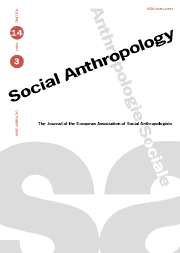Milk kinship in Islam. Substance, structure, history
Published online by Cambridge University Press: 06 December 2005
Abstract
The article critically interrogates an influential theory of Françoise Héritier and her associates that purports to explain Islamic milk kinship as the symbolic product of a peculiar Arab folk-physiology of lactation whereby breastmilk is supposed to be transformed male semen. In Part One, this somatic conjecture is shown to be unsubstantiated by extant ethnographies of milk kinship in the Middle East and North Africa. Reviewing its legal and social histories in Part Two, I indicate that the common deployment of Islamic milk kinship to cement clientage between status unequals, excluding their marital alliance, conditioned its clerical reckoning and symbolic legitimation on analogy with natal kinship. Its similar recognition in eastern Christian canon law, together with its structural parallels in spiritual kinship, suggest broader comparative anthropological prospects for comprehending this culturally distinctive – but by no means unique – Islamic institution of adoptive affiliation and clientage.
L'article propose une analyse critique de la théorie influente de Françoise Héritier et de ses collègues qui propose d'expliquer la parenté islamique par le lait comme le produit symbolique d'une physiologie folklorique arabe particulière de la lactation. Selon cette théorie, le lait maternel est supposé être issu de la transformation de la semence masculine. La première partie montre que cette conjecture somatique n'est pas prouvée par les ethnographies de la parenté par allaitement existant au Moyen Orient ou en Afrique du Nord. En faisant le compte rendu dans la deuxième partie de l'histoire légale et sociale de la parenté par allaitement, je montre que son usage répandu pour cimenter le clientage entre personnes de statut inégal, à l'exception de l'alliance matrimoniale, a fait reposé son évaluation cléricale et sa légitimation symbolique sur une analogie avec la parenté de naissance. Sa reconnaissance similaire dans le droit canonique chrétien oriental, ainsi que le parallèle structurel avec la parenté spirituelle, suggèrent un horizon comparatif et anthropologique plus large pour comprendre cette institution islamique de la filiation adoptive et du clientage – trait culturel caractéristique qui n'est en aucune manière unique.
Dieser Artikel hinterfragt kritisch eine einflussreiche Theorie von Françoise Héritier und ihren Mitarbeitern. In dieser wird die islamische Milchverwandtschaft als symbolisches Produkt einer seltsamen arabischen Volksphysiologie der Milchbildung verstanden, der zufolge Brustmilch eigentlich verwandeltes männliches Sperma ist. Im ersten Teil wird diese somatische Mutmassung als widersprüchlich zu noch immer gültigen ethnographischen Studien der Milchverwandtschaft im Mittleren Osten und Nordafrika präsentiert. Mit einem Überblick der Rechts-und Sozialgeschichte der Milchverwandtschaft im zweiten Teil zeige ich auf, wie der allgemeine Einsatz der islamischen Milchverwandtschaft die Stärkung der Patronagebeziehungen zwischen im Status ungleichen, ihre eheliche Verbindung ausgeschlossen, mit sich bringt und, gestützt auf einer Analogie mit der Geburtsverwandtschaft, klerikale Anerkennung sowie symbolische Legitimierung bedingt. Um diese sich kulturell abzeichnende, jedoch keinesfalls einzigartige, islamische Institution der adoptiven Verbindung und Patronage richtig zu begreifen, sind weitere vergleichende anthropologische Betrachtungen nötig, die sich mit einer ähnlichen Akzeptanz der Milchverwandtschaft seitens des östlichen, christlichen Gesetzeskanons sowie ihren Strukturparallelen mit spiritueller Verwandtschaft beschäftigen.
El artículo hace un cuestionamiento crítico a la conocida teoría de Françoise Héritier y adeptos que se propone explicar el parentesco islámico a través de la leche como el resultado simbólico de una peculiar fisiología popular árabe de la lactancia, a partir de la cual se piensa que la leche materna es semen masculino transformado. En la primera parte, con base en etnografía existente sobre los parentescos de leche en el Cercano Oriente y Africa del Norte, se demuestra que esta conjetura somática es insustancial. En la segunda parte, por medio de una revisión de su historia legal y social, pongo de manifiesto que el uso común del parentesco islámico de leche para cimentar una relación clientelista entre sujetos de distinto estatus, con excepción del contrato marital, condicionó su reconocimiento clerical y legitimación simbólica en analogía con el parentesco de sangre. Su similar reconocimiento en la ley canónica cristiana del Este, junto con sus paralelos estructurales de parentesco espiritual, requieren perspectivas antropológicas comparativas más amplias para comprender esta culturalmente particular – pero de ninguna manera única – institución islámica de afiliación adoptiva y clientelismo.
- Type
- Research Article
- Information
- Copyright
- © Cambridge University Press 2005
Footnotes
- 4
- Cited by




